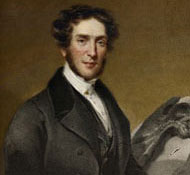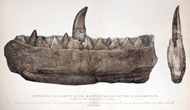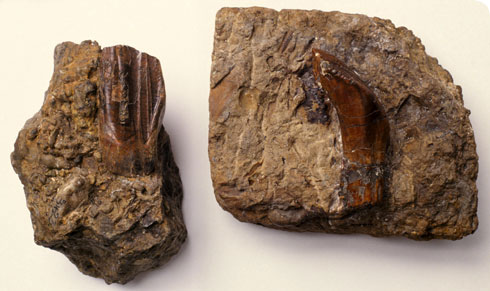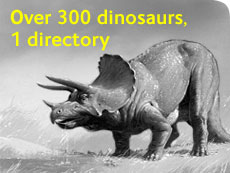Iguanodon teeth
The mysterious teeth found by Mary Mantell and her amateur palaeontologist husband Gideon in 1822 sparked the discovery of dinosaurs.

Gideon Mantell (1790-1852) with an Iguanodon bone, engraved from a 1837 painting by Samuel Stepney. © Paul D Steward / Science Photo Library
Evidence of giants
Mary Mantell unearthed the teeth as she pulled at loose fragments of rock by the side of the road in Sussex. Her husband Gideon, an amateur palaeontologist, noticed they were similar to modern iguana teeth, but many times larger.
Gideon had the imagination to suggest they belonged to a colossal ancient plant-eating lizard, which he named Iguanodon. He had no idea how big his idea was.
Hidden monsters
Huge carnivorous reptile fossils had lurked in the bowels of Oxford University's Museum since the late 1600s. The first keeper, Robert Plot, thought they belonged to a giant man, but in 1815 the academics began to realise the bones were reptilian.

Megalosaurus jaw and teeth from William Buckland's 1824 'Notice on the Great Fossil Lizard of Stonesfield'. © Paul D Stewart / Science Photo Library
After unearthing more and consulting other anatomists they confirmed their theory, eventually naming the reptile Megalosaurus in 1824. But until the Mantells discovered the Iguanodon teeth, no equivalent giant herbivorous reptiles had been found. The idea seemed implausible.
At first Gideon struggled to be heard by the scientific establishment. What did a provincial doctor and cobbler's son know? To his despair, experts dismissed the teeth as mammalian, and much younger than Mantell judged from the type of rock.
Mantell didn't give up. He found more teeth together with bones, and eventually convinced the experts he was right.

Invitation to a dinner inside an Iguanodon model on New Year's Eve in 1853, to celebrate Richard Owen's unveiling of life-size dinosaur models in Crystal Palace Park, London.
First dinosaurs
Over the next 20 years more giant lizard fossils were found. Then in 1842 Richard Owen, this Museum's first superintendent, did something ingenious. He announced a new name to group these land-dwelling reptile fossils. The Dinosauria, terrible lizards, grabbed the headlines and seeded a legend.
Iguanodon was one of the 3 genera (groups) Owen used to define dinosaurs, along with Megalosaurus and Hylaeosaurus, which was also discovered by Mantell.
Savage rivalry
Ruthlessly ambitious, Owen accepted the glory for the discovery of dinosaurs when Mantell believed it should have been his. Owen is still remembered as 'the man who invented dinosaurs'.
To Mantell, whose class had forced him to fight for recognition, Owen's behaviour was 'unworthy piracy... what a pity a man of so much talent should be so dastardly and envious'.
Further information
- Visit the Iguanodon teeth found by the Mantells in our new Treasures Cadogan Gallery.
- Explore facts, figures and images for over 300 dinosaurs in our Dino Directory.
Vote for your favourite treasure
Is this your favourite Museum treasure? Let us know by voting in our poll.
Listen to the Treasures podcast
Iguanodon teeth story

Dinosaur experts Paul Barrett and Susannah Maidment join amateur palaeontologist Karl-James Langford to investigate the teeth that kick-started the study of dinosaurs.

